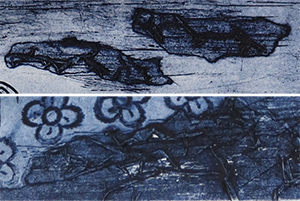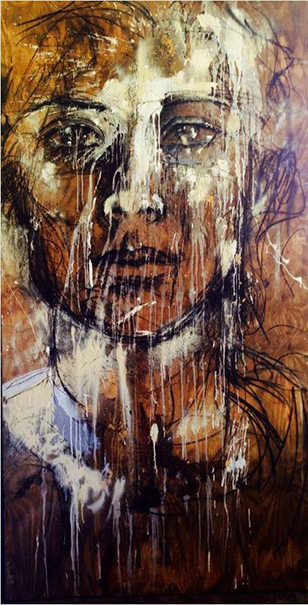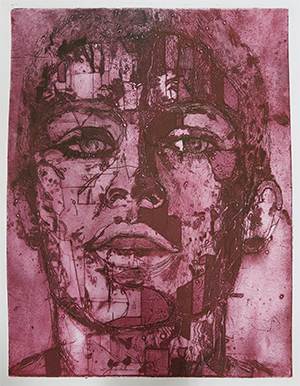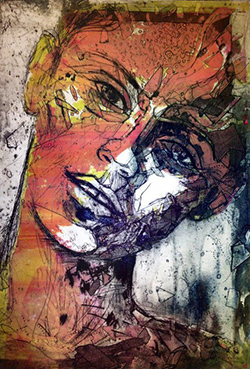Having been born to drug-addled parents living a life of instability and unpredictability, due to a set of extreme circumstances Jet James found himself an orphan at 8 years old.
He was taken from Perth (Australia) to live in some of the most remote areas of Queensland on cattle stations. Through this isolation and, with little or no influence, his talent for art became apparent and by his mid-teens he was already gaining recognition for his creativity.
As stated in my previous post, he and his mentor worked for two years developing a unique collagraph approach. This is based on not only adhering items to a surface but also embossing into the surface and using aerosols or pen style products to create flat (or almost flat) resists.
He applies colour, using oil based inks, using a spatula or similar in many cases. This is passed over the plate multiple times ensuring ink is pushed into the embossed marks, that it clearly defines the edging of resists and gives sharp outlines to built-up areas. As much as possible of the ink is then removed and paper is used to polish the print plate using varying pressure, enabling him to select sections where he can create depth of colour or reduced colour depending on the outcome he is aiming for.
He uses relief inks, which I found amazing as I’ve been repeatedly informed that you must use intaglio inks if you wish to force colour into embossed areas. It appears this isn’t always the case as Jet James successfully produces very fine line-work which prints precisely.
In the image, right, he has used the method described above and has achieved a very dimensional outcome by clever placement of his media and embossing techniques. Having seen it first-hand I can assure the viewer that very little of his fine detail can be understood from this photograph.
He is a big fan of masking tape, in fact all tapes. He also uses duct tape – which inks do not adhere to at all so producing stark white areas in his work – sellotape, builders tape and any other adhesive style tapes he can find.

Close up of masking tape texture. Top sample has been repeatedly slashed with a razor blade before inking.
Masking tape, being of a papery consistency , attracts the ink. Crumpled masking tape will form ridged areas of dense colour, whilst a flatter application will provide a lighter more even look. However, this does depend on how thickly the ink is applied, how quickly it is removed or polished away and how hard the pressure is to remove the colour.
Another method of printing he uses is to apply the inks to the plate surface using a cloth or spatula only in selected areas, somewhat like the dabbing I have been doing with OCA, and this allows him to blend colours as he wishes. Quite how he knows where to apply colour and where to leave blank is beyond me. Obviously there is reference to light and shadow but many of his decisions I find very unusual, but also very alluring, dynamic and powerful.
Much of his imagery concentrates on the human form, most often the face. Speculating with my OCA colleague Judy, who also attended the recent workshop Jet James held, I wonder whether this relates to thoughts of identity. He certainly comes from a very challenging start in life and has seen some horrors that must have left an impression and will remain with him for ever. Even at a young age seeing his parents heavily addicted to heroin and the effects that had, and the results from it, will have been an intense and frightening experience.
Moving from an urban area, with much turmoil, to the essentially empty outback would have been a huge shock. A total turnaround in life: initially a child in Perth having to look after himself, apparently breaking into his own house when his parents were incapable, getting himself to school and so on, to ending up in the vast wilderness of cattle ranches, mustering and probably a different set of hardships to endure.
With that as your start-in-life education who wouldn’t look at a question of identity? Who wouldn’t try to find their niche, their place in society? I feel a sense of searching and exploration in his works. However, very many of the faces he portrays are devoid of expression.
Resources:
Photo of ‘Unknown title, 2015’ taken by myself. Remaining images from artist website.
http://www.jetjames.com.au/portraits-and-figurative1.html
http://www.jetjames.com.au/about.html
http://www.jetjames.deviantart.com/
http://www.themorningbulletin.com.au/news/discovering-art-lets-jet-regain-direction-in-life/714413/
Photos and some text taken from the website with permission from the artist. Thanks, Jet, and thanks for the very valuable workshop as well.




Pingback: On seeing for yourself…. - WeAreOCA